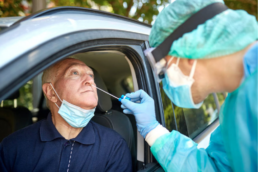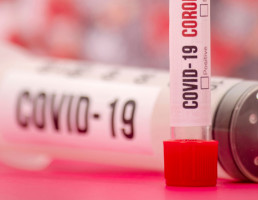Now Offering RT-PCR Testing with Results in 1 hour!
We NOW OFFER RT-PCR Testing with Results in 1 hour!
How does it work?
All testing is performed outside of the pharmacy, with parking in front of the pharmacy in any of the 15 minute parking spots. When you arrive at the pharmacy, please call our main line at 619-303-7771 and someone will be right out to assist.
Once you arrive our staff member will provide you with the testing kit. You will be instructed on the steps needed to complete the test. The test is an anterior nasal swab (it is inserted only at the tip of the nose). The test is completely self-contained – no mixing of fluids or complex testing procedure required. Once the swab is performed our staff will send your results via e-mail OR you may pick up your results once they are ready. Results may be ready in as little as 1 hour.
What is the age requirement for testing?
The minimum age for testing is 2 and above.
What is the Turn Around Time (When should I expect my results)?
The estimated turnaround time is 1 hour. Results will be sent via e-mail (or may choose to pick up) with same day results. If your results are NOT needed in 1 hour we offer additional turn around times. Please refer to "What is the cost of the PCR" for additional information on turn around times.
Is the Lab CLIA-certified?
Yes, our pharmacy has a CLIA waiver.
Is the test FDA approved?
The kit has an emergency authorization use by the FDA.
What is the cost of the PCR?
The cost varies on how soon you need your results.
Results within 48 hours is $175.
Results within 24 hours is $199.
Results within 1 hour is $329.
Do you accept health insurance?
At this time, we do not directly bill health insurance. We will be glad to provide you with a detailed receipt that you may wish to turn into your insurance to seek possible reimbursement.
Will it meet my travel requirements?
Due to ongoing changes and differences between airlines/countries/states requirement, we cannot assure that your results will be accepted for specific travel requirements. We recommend that you reach out to your airline/country for exact requirements and if the test RT-PCR test offered by Rancho Pharmacy will meet those requirements.
Does your test meet the requirements for Hawaii?
No our test will NOT be sufficient for travel to Hawaii.
I received a negative test what does this mean?
The Cue COVID-19 Test is a U.S. FDA Emergency Use Authorized molecular nucleic acid amplification test (NAAT) that detects the genetic material of SARS-CoV-2 using a molecular amplification reaction that is an equivalent amplification method to molecular polymerase chain reaction (PCR). A Negative result means that Cue COVID-19 Test did not detect SARS-CoV-2 virus in your sample.
How do I register?
You may register online on our website under COVID testing. Make sure to select PCR when choosing what type of the test. We also recommend you remind our staff member the type of test you wish to have performed.
What does it mean if the specimen tests negative for the virus that causes COVID-19?
A negative test result for this test means that SARS- CoV-2 RNA was not present in the specimen above the limit of detection. However, a negative result does not rule out COVID-19 and should not be used as the sole basis for treatment or patient management decisions. It is possible to test a person too early or too late during COVID-19 infection to make an accurate diagnosis via Cue COVID-19 Test.
In addition, asymptomatic people infected with COVID- 19 may not shed enough virus to reach the limit of detection of the test, giving a false negative result. In the absence of symptoms, it is difficult to determine if asymptomatic people have been tested too late or too early. Therefore, negative results in asymptomatic individuals may include individuals who were tested too early and may become positive later, individuals who were tested too late and may have serological evidence of infection, or individuals who were never infected.
When diagnostic testing is negative, the possibility of a false negative result should be considered in the context of a patient’s recent exposures and the presence of clinical signs and symptoms consistent with COVID-19. The possibility of a false negative result should especially be considered if the patient’s recent exposures or clinical presentation indicate that COVID- 19 is likely, and diagnostic tests for other causes of illness (e.g., other respiratory illness) are negative. If COVID-19 is still suspected based on exposure history together with other clinical findings, re-testing with an alternative method should be considered by healthcare providers in consultation with public health authorities. Additional testing may be helpful to ensure testing was not conducted too early.
Risks to a patient of a false negative test result include: delayed or lack of supportive treatment, lack of monitoring of infected individuals and their household or other close contacts for symptoms resulting in increased risk of spread of COVID-19 within the community, or other unintended adverse events.
The performance of this test was established based on the evaluation of a limited number of clinical specimens. The clinical performance has not been established in all circulating variants but is anticipated to be reflective of the prevalent variants in circulation at the time and location of the clinical evaluation. Performance at the time of testing may vary depending on the variants circulating, including newly emerging strains of SARS- CoV-2 and their prevalence, which change over time.
What does it mean if the specimen tests positive for the virus that causes COVID-19?
A positive test result for COVID-19 indicates that RNA from SARS-CoV-2 was detected, and therefore the patient is infected with the virus and presumed to be contagious.
Test results should always be considered in the context of clinical observations and epidemiological data in making a final diagnosis and patient management decisions. Patient management should be made by a healthcare provider and follow current CDC guidelines.
The Cue COVID-19 Test has been designed to minimize the likelihood of false positive test results. However, in the event of a false positive result, risks to patients could include the following: a recommendation for isolation of the patient, monitoring of household or other close contacts for symptoms, patient isolation that might limit contact with family or friends and may increase contact with other individuals with COVID-19, limits in the ability to work, the delayed diagnosis and treatment for the true infection causing the symptoms, unnecessary prescription of a treatment or therapy, or other unintended adverse effects.
#PCR#RT-PCR#NAAT#testign#covid-19
COVID Testing
We have all heard that the key to preventing the virus from spreading is testing. But what types of tests are available and which one is the best?
As far as COVID testing there is not one test that is the BEST. It all depends on the person’s situation. The best way to determine which test is best for you is to work with your provider or pharmacist. Here is some information about the three different categories of tests that are available: PCR (a nasal or throat swab), Antigen (a nasal or throat swab) and an Antibody (a blood test).
PCR and Antigen are considered diagnostic tests as they can detect the virus earlier, while an antibody test detects antibodies later on. None are available to purchased directly by the consumer at this time.
PCR test is best to be used before or during symptoms. The virus is easily detectable within 7 to 10 days of illness. The test uses a process to test molecular breakdown of the virus. The Abbott ID Now test which delivers results within as little as 5 minutes is a PCR test.
An Antigen test is not reliable until symptoms exist. The peak or optimum testing time is about 3 to 5 days. The test is testing the coating of the virus.
The Antibody testing does not focus on checking the virus itself, but whether your immune system has built antibodies in response to the infection. It involves a small finger prick blood sample that takes at least 10 days to detect IgM antibody. Around 2 to 3 weeks later it can also detect IgG. These tests should be performed only on people that never had symptoms or it has been at least 7 days since their last symptom. If tested earlier, clinical reliability may be compromised.
More about Antibody testing…
There have been reports about fraudulent tests that are being sold. Here are a few things to watch for. As of now, there are no antibody tests on the market that have FDA approval, this will change with time. Testing kits are registering with the FDA and some have been granted an EUA (emergency authorization) by the FDA, but they are still not FDA approved. If you choose to receive an antibody test you will want to ask the person offering testing if they have checked and validated that the test has been registered with the FDA. In addition, tests that are on the market should have used PCR and not ELISA to validate their negative and positive results, as PCR is considered “Gold Standard” for COVID.
As far as the antibody test it tests for the antibodies IgM and IgG. IgM is the first antibody response to be detected. If IgG is detected and the level has become higher than IgM this means the maximum immunity response has occurred.
Keep in mind that these are qualitative tests not quantitative tests. This means it does not tell you how many antibodies, so it does not tell you if you are immune or how long you are immune. To measure immunity, you need to measure a titer, similar to a titer test performed after receiving your hepatitis B vaccines.
Therefore, Antibody testing does not tell you if you are immune but it does help in making decisions as far as when a person can stop being in quarantine and return to the workforce. It also helps with identifying donors for COVID-19 convalescent plasma.
In addition, look for the following to be labeled on a test:
1. This test has not been reviewed by the FDA
2. Negative results do not rule out SARS-CoV2 infection, particularly in those who have been in contact with the virus. Follow up testing with a molecular diagnostic should be considered to rule out infection in these individuals
3. Results from antibody testing should not be used as the sole basis to diagnose or exclude SARS-CoV2 infection or to inform infection status
4. Positive results may be due to past or present infection with non-SARS-CoV2 strains, such as coronavirus HKU1, NL63, OC43, 229E

